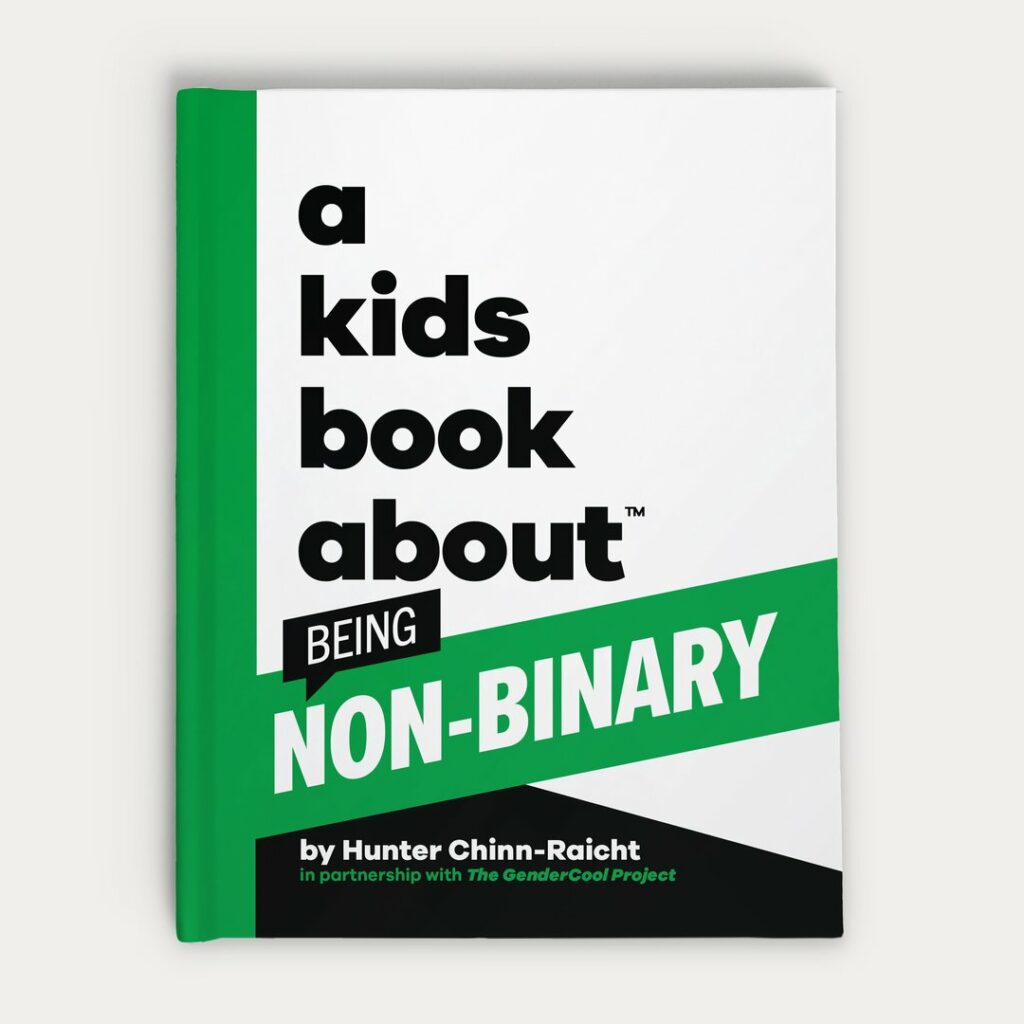LGBTQ+ people have always existed. But with increased media visibility and access to information online, there’s been a surge in awareness of transgender and nonbinary people, and younger generations feel empowered to come out earlier and in greater numbers.
A 2021 Gallup poll found that LGBT identification among all American adults is only up slightly (7.1%, compared to 5.6% in 2020). However, 21% of Generation Z Americans who have reached adulthood— those born between 1997 and 2003 — identify as being part of the LGBT community.
Hunter Chinn-Raicht is a nonbinary teen in Portland, Oregon, who uses they/them pronouns. When they came out and changed their name and pronouns, they felt affirmed in their identity, but they’ve run up against a general lack of understanding about the concept of being nonbinary and using gender-neutral pronouns.
“Luckily we’re at the point where I think we’re getting a lot of attention around people who are gender expansive, but it can be really confusing for people to understand a pronoun that has not been in their life at all,” Chinn-Raicht says. Now they’ve written the book — literally — on being a nonbinary youth. In partnership with GenderCool Project, Chinn-Raicht authored “A Kids Book About Being Non-Binary.”
Chinn-Raicht’s moms are a lesbian couple, though both parents acknowledge they still had a lot to learn about gender identity when their child came out. They’ve also found that embracing different gender identities often comes easier to kids than adults. Whether your child is nonbinary or has a nonbinary schoolmate or you simply want to discuss gender in your family, here are some important concepts about using nonbinary pronouns and navigating any slip-ups.
Understanding sex and gender as a spectrum
Many of us grew up with a binary concept of sex and gender. Upon birth, a person was assigned either the biological sex of male or female, depending on their anatomy, and it was considered unchangeable. Similarly, a person’s gender, under a binary social construct, was long linked to a person’s biological sex. We now know it’s not that simple; sex, as well as gender, are more nuanced and actually exist on a complex spectrum.
Quick glossary of gender identity terms*
Note: Gender identity terms (labels) are highly personal, so it’s important to ask and respect how a person identifies.
| Cisgender | Identifies with their sex assigned at birth, which tends to be most but not all people. |
| Nonbinary | Does not identify exclusively as male/a man or female/a woman; can also mean identifies as male and female, as somewhere in between or as somewhere outside of these categories. May or may not also identify as transgender since they don’t identify with their sex assigned at birth. Can be used as an umbrella term for being gender-fluid, agender, bigender or genderqueer. |
| Genderqueer | Does not identify exclusively as male or female but uses this alternate term to nonbinary, which is linguistically removed from the idea of a binary gender system. |
| Gender-nonconforming | Does not identify exclusively as male or female, or as nonbinary or genderqueer, but uses this term, which dismantles gender roles and stereotypes. |
| Genderfluid | Does not identify exclusively as male or female but fluctuates within the gender spectrum. At any time, they may shift to identify and/or present as more feminine and more masculine in a fluid way. |
| Agender | Does not identify within any gendered structures or spectrums. |
| Transgender | Identifies as a gender other than the one they were assigned at birth. We typically think of transgender people as moving from one binary identity to another, like male to female. |
Some people argue that our biology determines our identity, but this is easily disproved by intersex people — an estimated 1.7% of the population who are born with physical characteristics that aren’t strictly male or female. So rather than thinking there are only two black-and-white options for sex and gender, think of them as opposite ends of a spectrum, as shown in this model by the University of South Dakota. There’s room in between for those who feel they fit right in the middle, more one than other or a blend of the two.
Recognizing the importance of nonbinary pronouns
“When a person’s sex assigned at birth does not match the gender they identify with, this can cause distress that is often referred to as gender dysphoria,” says Dr. April Owen, a licensed clinical psychologist and gender therapist in Austin, Texas.
It’s common for nonbinary and/or transgender people to adopt a new name, pronouns and appearance that affirm their identity and ease dysphoria, according to the American Psychiatric Association.
It’s respectful and supportive to use a person’s identified pronouns
Nonbinary people often use gender-neutral pronouns, and while they vary by person, they/them pronouns are common. “Using a person’s identified pronouns is a simple, clear-cut way to indicate respect and support of their identity, and doing so can help alleviate additional dysphoria and distress for that person,” Owen continues.
Gender and pronouns are not based on a person’s appearance
It’s easy to fall into the trap of assuming someone’s gender and pronouns based on their appearance, Chinn-Raicht says, but this should be avoided. That’s because someone’s gender expression — the way they present to the outside world — doesn’t always tell you how they identify internally, they explain.
Don’t just assume a person’s pronouns
If you’re unsure of the pronouns of someone new, rather than assuming, Chinn-Raicht suggests sharing your own and opening the door for them to share theirs. “I like to say, ‘Hi, I’m Hunter, and I use they/them pronouns,’” they explain. In other situations, if they know the name but not pronouns, they might say, “Hey I think you’re cool. What are your pronouns?’”
“Hey, I think you’re cool. What are your pronouns?”
— Hunter Chinn-Raicht
Using they/them pronouns — and making mistakes
It’s understandable if these concepts are new and confusing and lead to some mistakes. What’s important is that you respect the nonbinary person’s identity and make the effort to use their correct name and pronouns, Chinn-Raicht says.
You can learn to use they/them pronouns even if it’s awkward at first
Yes, gender-neutral pronouns like they/them can sound wrong to your brain at first, and there may be a learning curve. Though if you think about it, you’ve probably used they/them pronouns in a singular sense and not realized it. For example, what would you say if an anonymous stranger left a book on a bench? Probably something like, “Somebody left their book behind!”
Chinn-Raicht says it helps that in 2019, the singular ‘they’ was officially added to the dictionary as a nonbinary pronoun. “Now we can point to something and say, ‘I know it seems incorrect because you were probably taught something different, but we’re changing that.’”
You will make mistakes sometimes
When you accidentally misgender someone, meaning you use the wrong pronoun, you may be embarrassed and feel compelled to apologize profusely. But overreacting will only make the situation worse, says one of Chinn-Raicht’s moms, Patricia Raicht.
“If you make a big deal of it and keep saying, ‘I’m so sorry, I feel so bad,’ then you’re shifting the focus on yourself instead of them,” Raicht explains.
“If you make a big deal of it and keep saying, ‘I’m so sorry, I feel so bad,’ then you’re shifting the focus on yourself instead of them.”
— Hunter Chinn-Raicht
And here’s what to do when you do mess up
“Even I get it wrong sometimes,” says Raicht. “What I’ve been told over and over by folks who have been misgendered is to just say you’re sorry, correct yourself — like, ‘I mean they’ — and then just move on. It doesn’t have to be a big event, and you will learn from it and try hard to not do it again.”
Chinn-Raicht says they understand the process of getting used to someone’s new name and/or pronouns can be bumpy. “We understand that it’s a shift, so it’s OK if you mess up — it all comes down to intent,” they explain. If you misgender someone maliciously, that’s unacceptable, but if it was a slip with good intentions, don’t beat yourself up. Just quickly apologize, correct yourself and move on, they say.
If you use the wrong pronoun (misgender) someone:
DO:
• Say you’re sorry and correct yourself.
• Move on.
• Learn from it and try hard to not do it again.
DON’T:
• Feel compelled to apologize profusely.
• Overreact.
• Make it about you.
Supporting a nonbinary child
Don’t worry about being perfect; the goal is to support LGBTQ+ youth. “When you support and affirm a child’s gender identity, you are giving that child the message that you hear them, see them and trust and believe what they know to be true about themself,” Owen says. “This kind of support can help children be their best, improve their quality of life and enhance their mental well-being.”
Here are some ways to offer support:
Normalize sharing pronouns
Being the only one to share their pronouns can make a nonbinary person feel singled out, Chinn-Raicht says. When cisgender allies make a point to share their pronouns, it can help normalize the concept.
“I use my pronouns everywhere, including at work,” Raicht says. She has them in her email signature and her Zoom name, and she starts her work meetings by sharing her name and pronouns. “You should say them even if you’re cisgender because that’s a sign you understand that there are people who are not cisgender, and you want to give them the opportunity to share their pronouns as well,” she says.
Run interference with family members
Chinn-Raicht’s other mom, Ann Marie Chinn, says they’ve had to step in and have some conversations with family members struggling to accept their child’s identity. “We say that we expect unconditional support and love for Hunter, and that they’re the same person,” she says.
Raicht adds that they don’t have to understand it — they can do their research — but they must respect it. “What we are saying is, if you want to have a relationship with this human, you need to respect the pronouns they choose and you need to not misgender them,” Raicht says. “If you love and support them, this is what they’re asking for, and this is what you need to do.”
Chinn-Raicht adds that it’s also crucial for family members to not out the youth — meaning, not share their identity — to others if they’ve been instructed not to. For some individuals, coming out is a gradual process, and it’s important that they get to decide who knows and when it can be shared.
Seek out resources
One way to educate your children, or support a nonbinary child, is through affirming resources.
Resources for gender-expansive youth
- GenderCool Project. Both moms rave about this youth-led movement.
- Gender Spectrum. Their mission is to create a gender-inclusive world for all children and youth.
- Family Equality. A virtual support and education space for LGBTQ+ families.
- Local LGBTQ+ resources, including:
- PFLAG chapters.
- Community centers.
- Youth programs with support groups.
- Events.
Here’s the bottom line
It’s OK if you’re struggling to understand nonbinary identities or they/them pronouns, Chinn-Raicht says. What is important is that you respect nonbinary people and their pronouns, and that if you mess up, you promise to keep trying.






